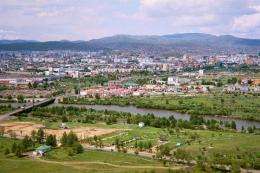November 17, 2011 weblog
Scientists embark on Mongolia ice-making experiment

(PhysOrg.com) -- Confronting temperature extremes of harsh winters and hot summers, Mongolia will now be the site of an experiment to address climate extremes and bolster supplies of water for its people. According to a report in The Guardian, scientists will get busy this month creating ultra-thick slabs of ice that will be used to cool this country's capital city during its hot summer. The Ulan Bator plan has excited numerous science sites. The effort is billed as one of the world's biggest ice-making experiments.
The Anglo-Mongolian engineering firm ECOS & EMI will recreate the natural ice-formation process by drilling bore holes into the ice that has started to form on the Tuul river. They are to repeatedly bore hole throughout the winter to grow the ice blocks.
Engineers refer to these as "naleds." They are thick slabs of ice that continue to expand for as long as there is enough water pressure to penetrate the surface.
As the slabs melt in the summer, they will, according to the plan, reduce city temperatures and save on energy otherwise used on air conditioners. They will also help regulate irrigation supplies and drinking water.
Mongolia is fitting for such an experiment, as a land of extremes. Its capital Ulan Bator is listed as the coldest capital city in the world yet has hot summers as well.
The Ulan Bator government is funding the project at an estimated cost of over $700,000. If successful, the engineers believe the process can be applied to other cities facing similarly difficult climate conditions.
Numerous aspects of environmental conditions need attention and there is reported to be a limited supply of safe water.
Reports note that the river Tuul, which flows through Ulan Bator, is beset by pollution. Some observers point to pollution from gold mining as well as insufficient sanitation facilities to accommodate an influx of residents. A third of the population lives in the capital. Traditional nomadic lifestyles have been upset by forces of climate change and urbanization. Observers point to a difficult environmental history where former Communist regimes promoted quick industrial growth with insufficient environmental laws resulting in serious pollution, deforestation, overgrazing, and soil erosion.
Nonetheless, some web blogs stared at the news report in disbelief that money could be spent on such an idea, suggesting it sounded wacky. Still, Mongolia-based scientists are confident the concept is sound. Robin Grayson, a geologist in Mongolia, said that naleds can be used to provide “cool parks” in cities. Grayson is the author of an earlier paper, “Asian Ice Shields and Climate Change” in which he says that protecting naleds would enable the mitigation of climate change across vast regions of Asia.
© 2011 PhysOrg.com
















